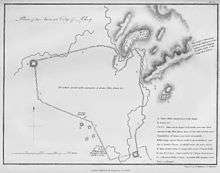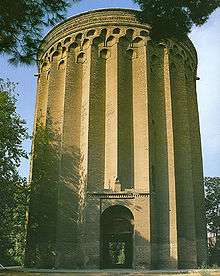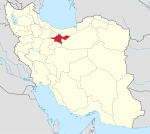Rey, Iran
| Ray ری | |
|---|---|
| District of Tehran | |
|
Up to down: 1st row: Fath Ali shah inscription---A local bazaar (Friday Bazar) | |
 Ray | |
| Coordinates: 35°35′N 51°26′E / 35.583°N 51.433°ECoordinates: 35°35′N 51°26′E / 35.583°N 51.433°E | |
| Country |
|
| Province | Tehran |
| County | Capital of Rey, but within Tehran |
| Time zone | IRST (UTC+3:30) |
| • Summer (DST) | IRDT (UTC+4:30) |
Rey or Ray [Pronunciation: rā] (Persian: شهر ری, Shahr-e-Ray, "City of Ray"), also known as Rhages (/ˈreɪdʒəz/; Greek: Ῥάγαι, or Europos (Ευρωπός) Rhagai; Latin: Rhagae or Rhaganae) and formerly as Arsacia, is the capital of Rey County in Tehran Province of Iran, and the oldest existing city in the province.
Ray today has been absorbed into the Greater Tehran metropolitan area. Ray is connected via the Tehran Metro to the rest of Tehran and has many industries and factories in operation. Limited excavations of what was not bulldozed began in 1997 in collaboration with the Iranian Cultural Heritage and Tourism Organization (ICHTO), the Department of Archaeological Sciences of the University of Bradford and the Department of Archaeology of the University of Tehran.
Note on spelling: According to the Iranian Chamber Society, the correct spelling of the city in both English and Persian is Ray, though variations in spelling also exist.[1] The city university also uses the spelling Ray ("Azad University, Shahr-e-Ray"),[2] as does the Encyclopædia Iranica published by Columbia University.[3]
History
A settlement began here c 6,000 BCE as part of the Central Plateau Culture. The settlement was used as a capital by the Arsacids called Rhaga. In Classical Roman geography it was called Rhagae. It is mentioned several times in the Apocrypha.[4] Its name dates back to the pre-Median period. Some historians attribute its building to ancient mythological monarchs, and some others believe that Ray was the seat of a dynasty of Zoroastrian leader.
During the Greek Macedonian occupation of Iran, Alexander's general Seleucus I Nicator renamed the city as Europos, honouring his country in Macedonia. Ray is richer than many other ancient cities in the number of its historical monuments, among which one might refer to the 3000-year-old Gebri castle, the 5000-year-old Cheshmeh Ali hill, the 1000-year-old Bibi Shahr Banoo tomb and Shah Abbasi caravanserai. It has been home to pillars of science like Rhazes.
Rey was one of the capital cities of the Seljuqs in the 11th century. In the 13th century after the Mongol conquest the town was severely damaged and it gradually lost its importance in the presence of nearby Tehran.
There is also a shrine there, dedicated to commemorate Princess Shahr Banu, eldest daughter of the last ruler of the Sassanid Empire. She gave birth to Ali Zayn al Abidin, the fourth holy Imam of the Shia faith. This was through her marriage to Husayn ibn Ali, the grandson of Muhammad, the prophet of Islam. A nearby mountain is also named after her. However, some sources attribute the shrine to the goddess of water and fertility, Anahita, claiming it was renamed in Islamic times to protect it from any possible harm after the conversion of Iranians to Islam.
In the middle of the 19th century Ray was described as place of ruins, the only settlement being around the shrine of Abdol Azim.[5] Being the only important pilgrimage site in vicinity to the royal court in the new capital Tehran brought more people to visit the shrine and a major restoration was sponsored by the court.[6] Thus Ray was the first place in Iran to be connected to the capital by a railroad in 1888.
Main sights


- Shah-Abdol-Azim shrine. The shrine contains the tomb of ‘Abdul ‘Adhīm ibn ‘Abdillāh al-Hasanī,[7] a fifth generation descendant of Hasan ibn ‘Alī[7] and a companion of Muhammad al-Taqī.[7] He was entombed here after his death in the 9th century. Adjacent to the shrine, within the complex, are the mausolea of Imamzadeh Imamzadeh Tahir, son of the fourth Shī‘ah Imam Imām Sajjad and Imamzadeh Hamzeh, brother of the eighth Twelver Imām - Imām Reza).
- Cheshmeh-Ali, hill with a spring. In 1933-6 Cheshmeh Ali hill was excavated by archaeologists from the Boston Fine Arts Museum and the University Museum at the University of Pennsylvania headed by Erich Schmidt, which resulted in the discovery of 7,000-year-old artifacts. Some of the discovered objects are displayed at museums in Iran, Chicago, and Philadelphia. The hill, which is now entirely leveled out and most artifacts unrecoverable due to real estate expansion in the 1980s and 1990s, was the home of Aryans about 6,000 years ago. Since Ray was used as a recreation center due to its beautiful attractions under the reign of the Qajar dynasty, Fath Ali Shah often used to explore the city. In 1831 his portrait and that of some Qajar princes were engraved on a rock at Cheshmeh Ali hill and its surrounding was decorated with tablets covered by poetry.
- Tuğrul Tower, constructed under the Seljuqs at the order of Tuğrul Beg in 1140, once he transferred the capital city from Nishapur to Ray. The tower is 20 meters high and the surface of its exterior is divided into 24 sections, which besides manifesting beauty and durability, symbolizes the figures of constellation as well as a 24-hour length of time (a day and a night).
- Shah Abbasi Caravanserai. One of the ancient residential and commercial complexes, which was used as a lodging by traders and located on the shrine street, close to the Bazaar. It comprises four verandas and is surrounded by stones all around, which used to serve as a market place where goods and commercial products were presented and sold by traders.
- Ray Bazaar. Located to the north of Shah-Abdol-Azim's shrine, it comprises two sections and a crossroad is formed at their intersection. It has long been a center for the sale of spices, traditional herbs, and commercial goods which were imported by traders via the Silk Road. The structure of the bazaar is constructed from plaster, brick, raw mud brick and mud. It dates back to the Safavid era and is approximately 500 years old.
- Anyanaj Tower, an octagonal tower known as Naqareh Khaneh stands on the slopes of Tabarak mountain. A cellar is linked to the tower from underneath through a vestibule erected outside. The tower, which is constructed by stone and plaster and decorated by brickwork and zigzag vaults, dates back to the Saljuk era.
- Gebri Crypt. Zoroastrians lived in this area, who used to leave the corpses of the dead in the open air usually on a structure known as a Dakhma (Persian: دخمه) or Tower of Silence. According to their traditions, once the flesh had decayed, the remaining bones would be buried. The ancient Zoroastrians disapproved of contaminating the earth (Zam) with a corpse through regular burial, or contaminating fire (Atar) through cremation (An afront to Armaiti and Asha respectively) due to the belief that corpses are nasu (unclean and impure). Gebri crypt was built as a high circular structure, six meters high, which was constructed by stone and mortar. It dates back to the 1st millennium BCE, around 3,000 years ago and was earlier called by different names, such as Khamoushan tower, Ostvaran, Ostkhan-ran, Marg (Death) tower and Sokout (Silence) tower.
- Paintings of Monarchs on Ashkan Mountain. At the order of Fath Ali Shah Qajar, a slide was erected on the Ashkan mountain as a sliding and recreation tool for the monarchic family. At the southern slopes of the mountain, a rough image of the Sassanid kings has been carved on a rock, which was leveled for this purpose. The image was left incomplete. Later at the order of Fath Ali Shah the image was erased to be replaced by his own portrait, while he had a crown on head and a spear in hand targeted at a lion.

Notable people
- Muhammad ibn Zakariya al-Razi
- Abu Hatim Muhammad ibn Idris al-Razi
- Abu Zur’ah Ar-Razi
- Abu Hatim al-Razi
- Amin Razi
- Harun al-Rashid
- Fakhr al-Din al-Razi
- Najmeddin Razi
- Morteza Avini
- Mohammad Reza Heydari
- Javad Nekounam
- Farzad Ashoubi
- Hadi Saei
- Alireza Dabir
- Hamid Sourian
- Mehdi Kamrani
See also
References
- ↑ "Iran Chamber Society: Iranian Cities: Shahr-e Ray". Retrieved 2 December 2016.
- ↑ "Islamic Azad University, Shahr-e-Ray - TOP ranked University - University Directory". Retrieved 2 December 2016.
- ↑ electricpulp.com. "FAHLAVĪYĀT – Encyclopaedia Iranica". Retrieved 2 December 2016.
- ↑ Judith 1:5, 15; Tobit 1:14, 5:5, 6:10
- ↑ Heinrich Brugsch, Reise der K. preussischen Gesandtschaft nach Persien 1860 und 1861, Leipzig 1862 , Volume 1, pp 230ff
- ↑ in 1854, cf art. ʿABD-AL-ʿAẒĪM AL-ḤASANĪ in iranicaonline.com
- 1 2 3 al-Qummi, Ja'far ibn Qūlawayh (2008). "107". Kāmil al-Ziyārāt. trans. Sayyid Mohsen al-Husaini al-Mīlāni. Shiabooks.ca Press. p. 658.
External links
| Wikimedia Commons has media related to Ray, Iran. |
- The Tehran province Cultural Heritage Organization.
- Archeological site of an ancient Fire Temple near Ray.
- Background on the 1934-1936 joint expedition financed by the University Museum at the University of Pennsylvania and the Boston Museum of Fine Arts led by Erich Schmidt
- Ali Spring (Cheshmeh Ali), Ray
- Toqrol Tower, Ray
- Daily Life Ornamented: The Medieval Persian City Of Rayy Special Exhibition at Chicago Oriental Institute (May 15-October 14, 2007).
| Preceded by Nishapur |
Capital of Seljuq Empire (Persia) 1043–1051 |
Succeeded by Isfahan |
